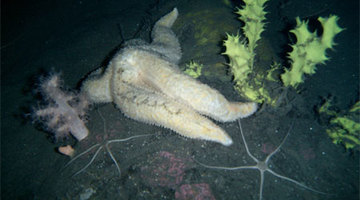Tagging marine invertebrates1 is very unusual! Dr Miles Lamare, from the University of Otago, talks about why they decided to tag the New Zealand starfish and what they hoped to discover.
Point of interest
Starfish is the common name for a group of animals called sea stars. Sea stars are actually part of the phylum2 echinoderm3 and are related to sea urchins, brittle stars and sea cucumbers – they are not fish at all!
Transcript
Dr Miles Lamare
A lot of research in the past has been done using scuba divers. And scientists would go and quickly observe them and see what was going on. You were basically then getting a snapshot of what was happening at the time you were there. Starfish don’t move particularly fast so you get the impression that things are static. We wanted to know what was happening over a long period of time when we weren’t even around, so by individually tagging starfish and monitoring their behaviour, we can understand exactly what an individual starfish is doing and how one starfish behaves compared to another starfish. Tagging marine species4 isn’t unusual because a lot of commercial fish species are tagged so that the fishery knows where the fish is going and where it’s eating its food and what have you. But tagging of invertebrates is a really, really unusual thing to do. Not many studies have done that. Like, for example, 1 year there were about 12,000 marine species tagged and, of those, 36 were invertebrates. So most tagging is done on large fish or marine mammals but not on the invertebrates themselves. So this is really new, new technology, new sort of science. So they’re tiny little tags that were developed mainly for the use of large fish, and they are placed on the starfish, and they continually record the time, what depth the animal is at, what temperature5 it’s exposed to and what salinity6 etc. So it records where it is in the water column7, I mean, in terms of up and down the rock wall, and also what oceanic conditions8 it’s exposed to at the time. So at any one time, we would tag about 5 out of the population9 – the tags are pretty expensive – so we tag about 5, and we would leave those tags on the animal for about 3 weeks, and then we would go back and dive for them and recover the animals. We remove the tag, and then there’s a… there’s a little communication box which we put the tag into, and that communication box then plugs into a computer. And then using software specific for that tag, we’ll communicate with the tag, get the data10 off it, and basically then go away and analyse it. So it’s attached to a computer and downloaded that way. What really struck us was how dynamic11 these starfish were. You know, when you go diving, you see all these starfish sitting on the sea floor, and you think, you know, OK, they’re sitting there, they don’t look like they are moving around much, but when you actually tag them for 3 weeks and then you let them do their thing, come back and look to see what their behaviour’s been, it’s really dynamic.
Acknowledgement:
Jomilo


